![]()
![]()
![]()
Use LEFT and RIGHT arrow keys to navigate between flashcards;
Use UP and DOWN arrow keys to flip the card;
H to show hint;
A reads text to speech;
63 Cards in this Set
- Front
- Back
|
Define Autotroph
|
an organism that uses carbon dioxide as its principle carbon source (chemoautotroph, photoautotroph)
|
|
|
Define heterotroph
|
an organism that requires an organic carbon source; also called organotroph
|
|
|
Eukaryote
|
DNA inside a distinct membrane-enclosed nucleus
|
|
|
Prokaryote
|
Genetic material not enclosed in a nuclear envelope
|
|
|
Describe the major characteristics of bacteria and archaea
|
Bacteria: - relatively simple, unicellular, - prokaryotes -cell walls composed of peptidoglycan -divide by binary fission -can be both motile and non-motile Archaea: -prokaryotic -if they have cell walls they lack peptidoglycan -live in extreme environments (thermophiles, halophiles, methanogens) |
|
|
Describe the major characteristics of fungi
|
-Eukaryotes -genetic material is DNA -Unicellular or multicellular -cell walls made of chitin -sexual and sexual -autotrophic (obtain nutrients from their environment) -unicellular: yeasts |
|
|
Major characteristics of protozoa
|
-unicellular eukaryotes -move by pseudopods, flagella, or cilia -autotrophic and heterotrophic -sexual and asexual |
|
|
Major characteristics of algae
|
-photosynthetic eukaryotes (photoautotrophic) -sexual and asexual -usually unicellular -cell walls made of cellulose -important in the balance of nature (cyanobacteria) |
|
|
Major characteristics of parasitic worms
|
-multicellular eukaryotes -heterotrophic -both motile and non-motile -sexual and asexual |
|
|
Major characteristics of viruses
|
-acellular (neither pro- or eukaryotes) -genome composed of DNA or RNA -reproduce by "hijacking" other cells to copy their gene material -enveloped in a capsid -can cause disease |
|
|
Major characteristics of prions
|
-acellular -pure protein -cause disease by conversation of glycoproteins into an infectious form -cause few diseases in humans including spongiform encephalitis |
|
|
Describe the major roles of microbes in the environment
|
-maintain the earths ecological balance -form basis for food chain in aquatic ecosystems -microbes in the soil break down waste into organic compounds -play roles in photosynthesis, oxygen generation, digestion and metabolism |
|
|
Explain why microbes are essential for life, as we know it, and the processes that support life.
|
-Cyanobacteria are critical to O2 on earth (procudes carbs + O2 as products of photosynthesis) -Nitrogen fixing bacteria that convert nitrogen gas into ammonium, usable to cyanobacteria. -Microbes are vital for digestion and metabolism -Penicillin produces as a product from a fungus and antibiotics have stemmed from that |
|
|
Explain how microorganisms are ubiquitous and live in diverse and dynamic ecosystems
|
-archaea (thermophiles, methanogens, halophiles) can be present in many extreme conditions; extreme heat, salt concentrations and gas. -present in water, air, soil and just about everywhere! -present in GI tracts of animals -various microorganisms can use aerobic, anaerobic, and fermentation -virulence factors, quorem senseing, and attachment structure such as fimbriae allow them to establish. |
|
|
Describe the role of nitrogen fixing bacteria in the environment
|
-present in soil or in plant roots -Heterocysts (specialized cells) contain enzymes that fix nitrogen gas (N2) into ammonium (NO4+), a usable form of nitrogen for cyanobacteria and plants. |
|
|
Describe the role of cyanobacteria in oxygen production on earth
|
-critical to O2 on earth -fossil records show with increase in cyanobacteria over thousands of years, oxygen content of the year has increased from 0.1% to its present concentration of about 20% -when cyanobacteria go through photosynthesis, they produce carbohydrates and O2 |
|
|
List the four major components of ALL cells
|
1) genetic material 2) ribosomes 3) cytoplasm 4) plasma membrane |
|
|
Define Genome
|
a complete copy of genetic information in a cell
|
|
|
Describe the major differences between prokaryotic cells and eukaryotic cells
|
Prokaryotes: -no membrane bound organelles or membrane-enclosed nucleus -simple -smaller -70s ribosomes Eukaryotes: -membrane bound organelles and membrane-enclosed nucleus -larger -more complex |
|
|
List the three domains of life
|
1) bacteria 2) archaea 3) eukarya |
|
|
Define phylogenic tree
|
involves grouping organisms according to common properties implying that a group of organisms evolved from a common ancestor
|
|
|
Draw a phylogenetic tree showing the three domains of life and the evolutionary relatedness of differential microorganisms
|
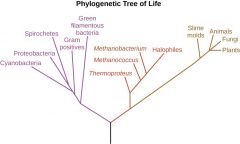
|
|
|
Describe the principles of cell theory
|
-Cells are the smallest unit of life -All cells are derived from previous cells -All living things are made of cells |
|
|
Define endosymbiotic theory
|
theory stating that eukaryotes evolved through a process whereby different types of free-living prokaryotes became incorporated insider larger prokaryotic cells and eventyally developed into mitochondria, chloroplasts, and possibly other organelles
|
|
|
What are the 7 characteristics of life?
|
1. composed of cells 2. levels of organization 3. use energy 4. respont to environment 5. grow 6. reproduce 7. adapt to their environment |
|
|
Describe the theory of Spontaneous Generation
|
the belief that forms of life could arise spontaneously from non-living matter (until the second half of the 19th century)
|
|
|
Describe the key experiments by Pasteur that disproved the theory of spontaneous generation
|
-beef broth flasks, a few days later, those that were sealed had microbial growth, those that were open had microbial growth -showed microbes present in air contaminated non-living matter, air doesn't create microbes |
|
|
Describe the germ theory of disease
|
-after realizing yeasts play role in fermentation, link was made between activity of microorganisms and physical and chemical changes in organic materials -showed possibility that microorganisms may have similar relationships with plants and animals (particularly that microorganisms may cause disease) |
|
|
Define pathogen
|
a disease-causing organism |
|
|
List and describe Koch's Postulates
|
German physician established microorganisms cause specific disease by: 1) the same pathogen must be present in every case of the disease 2) the pathogen must be isolated for the diseased host and grown in a pure culture 3) the pathogen for the pure culture must cause the disease when inoculated into a healthy, susceptible labratory animal 4) the pathogen must then be isolated from the inoculated host and be shown to be the original organism |
|
|
Describe the molecular Koch's Postulates
|
-investigate phenotype of associated genus or strains of species -specific inactivation of genes associated with suspected virulence should be isolated molecularly -deletion or specific inactivation of genes should lead to loss of function in clone -reversion or replacement of alleles should lead to restoration of virulence, or replacement of the modified gene(s) for it's allelic counterpart in the original strain should lead to its loss of pathogenicity/virulence -When pathogenicity is restored, reintroduction of wild-type genes should follow |
|
|
Use the Cell Theory and the characteristics of life to describe what modifications of our understanding of "life" would be required to categorize viruses and prions as living
|
-Viruses and prions are acellular, they cannot grow and reproduce without using their hosts ~prions convert glycoproteins into an infectious form ~viruses hijack the metabolism of host cells to copy their genetic material -neither metabolize -they are not composed of cells |
|
|
Explain how eukaryotic cells, organelles (e.g. mitochondria and chloroplasts), and all major metabolic pathways evolved from early prokaryotic cells. Describe the evidence that supports this theory.
|
-(Endosymbiotic theory) mitochondria and chloroplasts contain 70s ribosomes which are the ribosome type found in prokaryotes. -This supposedly happened due to an engulfment event, where free-living prokaryotes became incorporated inside larger prokaryotic cells and eventually developed into mitochondria and chloroplasts. |
|
|
Describe Robert Koch's contribution to microbiology
|
-He created a series of steps to follow so a specific bacteria can be proven to cause a specific disease -also lead to molecular Koch's Postulates and gene manipulation to see what genes in bacteria cause its pathogenicity or specific virulence traits -if we know which bacteria and which genes cause disease, we have a better idea as to how to create antibiotics and medications |
|
|
Show how Koch's Postulates and/or the molecular postulates can be used to prove a particular microorganism causes a particular disease
|
1) list the steps of Koch's postulates 2) describe molecular postulates 3) discuss how Koch's postulates proves a microbe is present in every case of the disease and infects the inoculated host and can be re-isolated 4) in molecular Koch's postulates, genes and specific virulence traits can be demonstrated through specific deactivation or deletion of genes and loss of pathogenicity or virulence in clones indicates the genes targeted are linked to those phenotypes. Also with reversion, restoration is such traits should further indicate the link. |
|
|
Describe the advantages and disadvantages of using molecular postulates versus Koch's postulates to identify the causes of disease
|
Koch's postulates -involves the infection and possible death of inoculated laboratory hosts. -Koch's postulates generally can show if a certain microbe is associated with a disease but it will not show exactly what about the microbe causes certain aspects of infection the way molecular postulates can. Molecular postulates -can be done without innoculating a susceptible laboratory host. -can be used to identify which genes cause pathogenicity or specific virulence. |
|
|
Explain how Fredrick Griffith used the molecular Koch's Postulates to establish what turned Streptococcus pnemoniae into a disease causing organism
|
-he isolated 2 strains -1 strain unencasulated; didnts cause disease on its own -2nd strain encapsulated; did cause disease -heat treated encapsulated strain inoculated in host (mouse) ; host lived -unencapsulated strain introduced; host lived -both heat treated encapsulated and unencapsulated introduced; host died -genes from dead bacteria entered live cells and changed them to become encapsulated |
|
|
Describe how the germ theory of disease has changed our view of disease and health (intuitive)
|
The general public is now much more aware of how disease is spread and how one can protect themselves and others by: -(sometimes required) testing for diseases (such as TB) -washing of hands -sterilization and disinfectants -vaccinations and antibiotics -medications and supplements to support immunity -protect yourself from the sick (PPT) -pesticides and pasteurization |
|
|
Define epidemiology
|
the science that studies when and where diseases occur and how they are transmitted
|
|
|
Defin pandemic, endemic, and epidemic
|
Pandemic- an epidemic disease that occurs worldwide Endemic- a disease constantly present in a population Epidemic- when many individuals in a given area acquire a certain disease in a relatively short period |
|
|
Define carrier state
|
individuals who harbor the pathogens and can transmit them withough symptoms
|
|
|
Define emerging and re-emerging disease
|
Emerging disease- diseases that are new or changing, showing an increase in incidence in the recent past or a potential to increase in the near future Re-emerging disease- have been a major health problem in the past, declined, and have come back to affect a significant proportion of the population once again. |
|
|
Identify some of the factors that are leading to an increase in the number of emerging and re-emerging diseases that are seen today
|
-new strains of infectious diseases (may result fromrecombination between organisms) -a new serovar, changes of the evolution of existing microorganisms -the widespread/unnecessary use of antibiotics -Global warming and changes in climate increase species distribution and survival -modern transportation -previously unrecognized infections my appear in those in areas of ecological change (can be brought by natural disaster, construction, war, growing population) -animal control measures can affect disease incidence -failures in public health measures can contribute to disease spread and emergence of previously controlled infections |
|
|
Describe how humans utilize and harness microbes and their products for medicinal purposes
|
Vaccines: introduction of disease in less virulent form to host so they can build immunity against the disease when exposed in the future Antibiotics: penicillin was discovered as an antibiotic produced bya fungus. From this discovery thousands of antibiotics have been produced to fight bacterial infection |
|
|
Discuss the historical significance and etiology of typhoid fever and stomach ulcers (articles)
|
Helicobacter Pylori: a bacterium that can live in the stomach, a carcinogen that can cause peptic ulcer disease and stomach cancer -anti-H. pylori antibodies can be found in blood of those infected -common bacterial agent, at least 30-50% of the world's population is colonized with it -more common among poorer socioeconomic groups and developing nations -most infected before age of 10 -poor sanitation and crowding contribute -transmitted through oral-oral or fecal-oral pathways -20% of infected had ulcers -Discuss Warren and Marshall experiment and how Marshall ingested the bacteria to prove Koch's postulates. Typhoid fever: can cause fever, continual headache, diarrhea, fever usually declines but can be fatal. Spread through fecal-oral route. -Late 1800's -Discuss Typhoid Mary for historical significance |
|
|
Describe the ethical and medical challenges to the carrier state in treating infections
|
Carriers are asymptomatic so unless the disease happens to be caught in a blood draw or otherwise, it will go untreated.
|
|
|
Case study: Given details of an emerging or re-emerging disease, be able to outline how one would go about identifying and proving the cause of disease
|
Use Koch's Postulates -Test the infected individuals (blood draw, etc.) Bacteria must be present in every case of the disease -Pathogen isolated and grown in a pure culture -Pathogen from pure culture must infect healthy, susceptible lab animal with same disease -pathogen then reisolated from inoculated lab animal |
|
|
Case study: Be able to us correct scientific terms to describe and identify the major groups of microorganisms
|
-use knowledge of bacteria, archaea, protista, eubacteria, Animalia (helminths), viruses, algae and fungi.
|
|
|
Describe the shape and/or cell arrangement of the following groups of bacteria: coccus, bacillus, spirochete, staphylococcus, streptococcus, and diplococcus
|
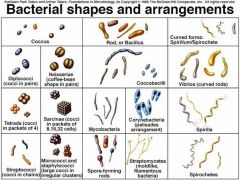
|
|
|
Define binomial nomenclature
|
-the 2 names assigned to a particular organism using is genus and specific epithet (species). Both names printed as underlined or italicized. -The genus is capitalized; species name is lowercase. |
|
|
Write the scientific name of a bacterial species using correct binomial nomenclature including genus, specific epithet (species)
|
For example: Streptococcus pnemoniae (italicized) |
|
|
List the criteria for making a drawing of a microscopic field of view
|
-Name specimen using binomial nomenclature -list the name of the stain used or wet mount -include total magnification used -label all observable structures and structures you are asked to find or identify -appriately color images drawn |
|
|
Use the criteria for drawing a microscopic field to actually draw and label a specimen
|
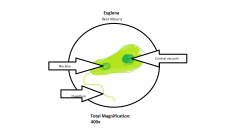
|
|
|
List the three reasons it is important to heat fix a slide prior to staining
|
1) kills bacteria 2) fixes them to the slide 3) preserves various parts of microbes in their natural state with only minimal distortion |
|
|
Even though fungi, protozoa and algae carry out some of the same process as bacteria, how do many of the cellular properties fundamentally differ?
|
Fungi: both auto+heterotrophs, uni+multicellular, eukaryotic, non-motile, asexual and sexual, cell wall composed of chitin, mitosis and binary fission. Protozoa: both auto+heterotrophs, unicellular, eukaryotic, both motile and non-motile, mitosis and binary fission, both sexual and asexual, no cell wall. Algae: photoautotroph, usally unicellular, eukaryote, non-motile, both mitosis and binary fission, sexual and asexual, cell wall made of cellulose Bacteria: auto+heterotrohpic, unicellular, prokaryotic, both motile and non-motile, binary fission, asexual, cell wall composed of peptidoglycan |
|
|
Be able to identify and compare the structure and major identifying characteristics of bacteria (including bacillus, coccus, spirochetes, and cyanobacteria), fungi (including yeasts and molds), algae, and helminths (flat and round worms) and protozoa.
|
Protozoa: motility structures (pseudopods of amoeba, cilia and flagella) Fungi: spores on multicellular, budding round cells of yeast Cyanobacteria (anabaena): long strands of photosynthetic cells and occasional heterocysts Helminths: most obvious, multicellular, seen by the eye, long bodied heterotrophs Bacteria: very small compared to eukaryotes, found to be round (cocci), rods (bacilli), and spirals (and arrangements.. remember them??) *refer to lab for drawings |
|
|
Indentify the following structures of eukaryotic cells from an actual specimen, photograph, description of funtion: nucleus, cell membrane, cell wall, cytoplasm, cilia, flagellum, pseudopod, bud, hyphae mycelium, spores, and chloroplast.
|
*refer to lab Protozoa Amoeba: move by pseudopods, contain: cell membrane, nucleus, cytoplasm Perinea and Euglena: flagella, nucleus, cell membrane, cytoplasm, chloroplast Paramecium and Stentor: cilia, cytoplasm, cell membrane Fungi Penicillium of Rhizopus: hyphae, spores shown in slide Yeast: buds and yeast cells |
|
|
Be able to construct a dichotomous key to identify different microorganisms
|
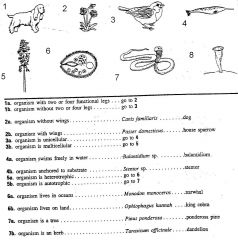
-2 choices, start broad, get more specific -using words, non-visual -end should identify microorganisms |
|
|
Be able to constuct a flow chart (decision tree) to identify different microorganisms
|
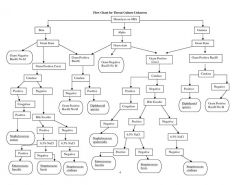
(example)
|
|
|
Describe the virulence factors of H. pylori that allow it to colonize in the stomach
|
-Sheathed flagella: protects flagella and moves bacteria through acid into the mucous layer -Urease: converts the urea into ammonia for a more neutral pH -Vac A: increase production of urea by mucosal cells to increase ammonium by urease to maintain its own neutral pH environment |
|
|
What is the infective dose of serotype Typhi?
|
10^5
|
|
|
Describe the characteristics that indicated that Mary Mallon was a carrier of typhoid bacillus. How can Salmonella serotype typhi establish semi-permaent infection and how is it related to the character state?
|
-typhoid was found in her stool and every place she worked there was a typhoid outbreak -the pathogen is harbored in the fall bladder and sheds for several months, this can occur indefinitely as well (such as with Mary Mallon) |
|
|
Describe the differences between flagella, cilia and pseudopods
|
Flagella: long filaments extending from bacteria for movement. Composed of flagellin in prok., microtubules in euk. Cilia: projections that are numerous and shourt for locomotion Pseudopods: an extension of eukaryotic cell that aids in locomotion and feeding. -lobe-like projections that the cell flows toward |

